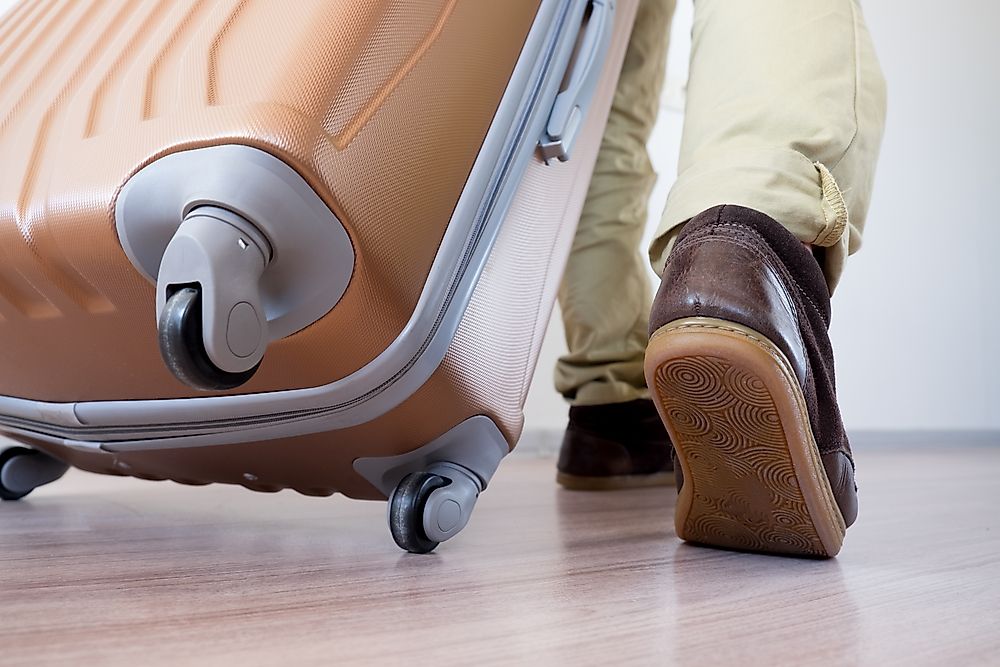Did You Know That We Went To The Moon Before We Put Wheels On Suitcases?

1969: Man on the Moon, Yet Still No Luggage on Wheels
On July 20th, 1969, the world was celebrating the first landing of man on moon. While American astronauts Neil Armstrong and Buzz Aldrin were busy collecting lunar material from the surface of the moon, travelers far away back home were struggling mightily to manage their heavy suitcases in their arms, constantly complaining about the weight of their luggage. Though it is hard to imagine traveling without wheeled luggage carriers in today’s world, only half a century ago people had to completely rely on their upper body strength to travel.
How the Idea Struck
More than forty years back, Bernard Sadow, the former president and owner of U.S. Luggage company, was traveling back home after a vacation with his wife and children in the Dutch Caribbean Island of Aruba. That is when he observed something that was to change the future of travel suitcases forever. While at the airport in Puerto Rico, where he was himself experiencing the constant discomfort at having to carry two large, heavily packed suitcases in his hands, he happened to observe a man effortlessly carrying a piece of machinery on a wheeled platform. This was when the brilliant idea of using wheels on suitcases stuck in his mind.
The First Wheeled Luggage
Once back home, Sadow went to his Fall River, Massachusetts factory, where he experimented with different arrangements of wheels on luggage, and directed the manufacture of suitcases incorporating his newly planned designs. Four steel trunk coasters were attached to the bottom of such suitcases, and a flexible strap was added to facilitate the pulling of the luggage like the leash of a dog. Soon, Sadow was roaming from one retail store to another attempting to convince the store managers to accept his new product. Though his idea was ridiculed in the beginning, finally the Vice President of the U.S. department store Macy's found his new product quite impressive, and agreed to sell it. In 1970, Sadow applied to the U.S. government for a patent on his new innovation, and was granted one in 1972, earning him the United States patent No. 3,653,474 for the ‘Rolling Luggage’. From October of 1970 onward, Sadow’s wheeled luggage were on sale at Macy’s, and soon became quite popular worldwide. Though not completely free of problems, such as tipping and wobbling, these suitcases greatly eased the burden of carrying heavy baggage, and earned a great deal of praise from the now hassle-free travelers.
The Advent of the Rollaboard with Retractable Handles
Further enhancements in Sadow’s model of wheeled luggage took place nearly 20 years after his innovation. It was at that time when a Northwest Airlines pilot named Bob Plath invented the two-wheeled luggage with retractable handles in 1987. This new innovation was called the ‘Rollaboard’, and was the first product of what was to become Plath’s future luggage company: Travelpro. The first Rollaboard luggage were sold by Plath to his fellow crew members, but soon became popular among all travelers. Since then and even until the present day, travelers from all around the world are using this new luggage. Today, in fact, anyone from a man to a woman or even a small child is able to easily carry heavy baggage without the need to challenge their upper body strength.
What Took Us So Long?
We have often wondered about what took us so long to invent something as simple as a wheeled luggage, especially at a time when our men were already taking their first steps on the moon. Most probably, the fact that carrying luggage was a ‘macho thing’ in the early days, and that women and children hardly traveled alone, could have slowed down the expressed need for, or desire of, wheeled luggage. However, as the world advanced and long-distance travel by flights became more common, and as more women began to travel alone on business trips, the need for a convenient luggage system became more evident. This led to the worldwide acceptance of the Rolling Luggage, and then the Rollaboard, in the second half of the 20th Century.











